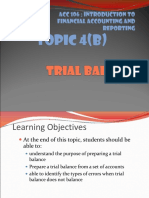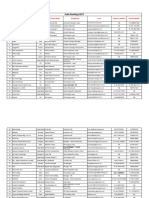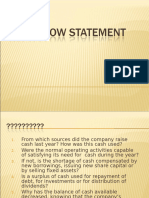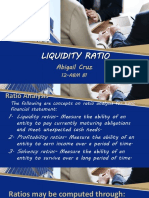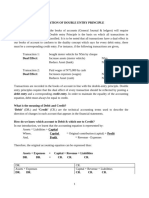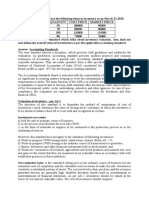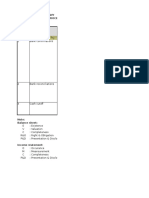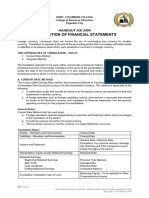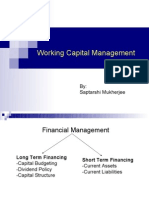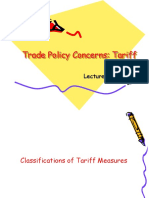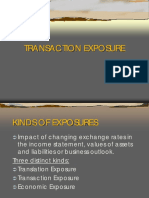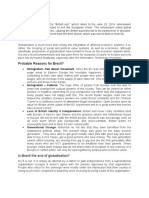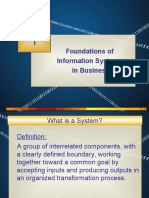Session 11
Session 11
Uploaded by
Aman VarshneyCopyright:
Available Formats
Session 11
Session 11
Uploaded by
Aman VarshneyOriginal Description:
Copyright
Available Formats
Share this document
Did you find this document useful?
Is this content inappropriate?
Copyright:
Available Formats
Session 11
Session 11
Uploaded by
Aman VarshneyCopyright:
Available Formats
TRANSLATION EXPOSURE
International Financial Management; Eun & Resnick
International Financial Management; Jeff Madura
Accounting Standards and Corporate Accounting Practices; T P Ghosh
Accounting Standards AS 11, 23 of ICAI
MEANING
Also called Accounting exposure
The impact of the changes in the exchange
rates on the consolidated accounts with
respect to profitability, assets and liabilities of
the MNCs
MNCs are required to consolidate accounts
of all its subsidiaries in the domestic
currencies. The accounts of each subsidiary
are drawn in the currency of the country it is
located, and therefore need to be translated
from the foreign currency to domestic
currency.
Rajiv Srivastava Translation Exposure 2
DOES IT MATTER
As long as profits of the subsidiary are not
remitted it does not matter irrespective of
depreciation or appreciation, currency will
go to meet the asset and liabilities in that
currency.
Cash flows to the parent are not affected in
the immediate future.
However, at some point it makes the
difference.
Rajiv Srivastava Translation Exposure 3
THE IMPACT
Can affect earnings: Impact on share price
since markets are driven by earnings and the
PE ratio. Cash flows????
Impact is governed by
Extent of dependence of parent on subsidiary
(Suzuki-Maruti)
Strength of foreign currency
(Subsidiary in Africa vs. Europe, Currency crisis of
South East Asia)
Accounting method
Rajiv Srivastava Translation Exposure 4
THE IMPACT
When exchange rates change the value of
liabilities and assets as well as profit change.
Impacts ratios of profitability, capital
structure.
Translation does not impact cash flows.
Impact on cash flows for the transactions
denoted in foreign currency is known as
transaction exposure.
Rajiv Srivastava Translation Exposure 5
TRANSLATION METHODS
Many rates are available
Opening Rate
Closing Rate
Average Rate
Historical (Actual) Rate
At what rate to translate the accounts??
FOUR METHODS:
Current/Non Current
Monetary/Non-Monetary
Temporal
Current
Rajiv Srivastava Translation Exposure 6
TRANSLATION METHODS
Current/Non Current method
Assets and liabilities: classified as per maturities.
short term Like current assets/current liabilities: translate at
current rate
Non current liabilities/asset:
translate at historical rates.
Monetary/ Non Monetary Method
Monetary items (Cash, AR,AP): at Current rate
Non Monetary items &Equity: Historical rates
Temporal Method
Same as Monetary/Non Monetary except stocks valued
current.
Current Rate Method:
All items at current rate except equity; Easiest to apply
Rajiv Srivastava Translation Exposure 7
TRANSLATION METHODS
Current Monetary Temporal Current
Non Current Non Monetary
Cash C C C C
Receivable C C C C
Payables C C C C
Inventory C H C C
Fixed Assets H H H C
LT Liabilities C C C C
Equity H H H H
C: Current Exchange Rate
H: Historical Exchange Rate (On the date of transaction)
Rajiv Srivastava Translation Exposure 8
EXAMPLE a: Average, c: closing, h: historical
Opening 2.00, Closing 3.00, Average 2.50 historical: 3.00
r: current market value at historical
Amount (FC) Current/ Monetary/ Non Temporal Current
Non Current Monetary
Sales 10,000 4,000 a 4,000 a 4,000 a 4,000 a
COGS 7,500 3,000 a 2,500 h 3,000 a 3,000 a
Depreciation 1,000 333 h 333 h 333 h 400 a
PBT 1,500 667 1167 667 600
Tax 40% 600 267 467 267 240
PAT 900 400 700 400 360
BALANCE SHEET
Cash 2,100 700 c 700 c 700 c 700 c
Stocks 1,500 500 c 500 h 900 r 500 c
Current 1800
Fixed Asset 3,000 1,000 h 1,000 h 1,000 h 1,500 c
TOTAL 6,600 2,200 2,200 2,600 2,700
CL 1,200 400 c 400 c 400 c 400 c
Debt 1,800 600 h 600 c 600 c 600 c
Equity 2,700 900 h 900 h 900 h 900 h
Reserves 900 400 700 400 360
Translation - -100 -400 300 440
TOTAL 6,600 2,200 2,200 2,600 2,700
Rajiv Srivastava Translation Exposure 9
TRANSLATING TRANSACTIONS
Indian firms having subsidiaries abroad are
governed by Accounting Standards
AS 11 (for translation) and
AS 21 (for consolidation).
All transactions like sales, purchases
denominated in foreign currency are
translated in the local currency. (AS 11)
Classify in Monetary & Non-Monetary items
Depends on
If settled in the same period as that of
transaction
If a forward cover has been taken
Rajiv Srivastava Translation Exposure 10
TRANSLATING TRANSACTIONS
Two approaches
1. Record initial transaction and charge difference of
rates upon settlement to FE gains/Loss for monetary
items keeping the non monetary items untouched:
A) Book unrealised gains on date of Balance sheet,
then on final settlement.
B) No unrealised gains, book realised gains upon final
settlement.
2. Charge FE fluctuations to non monetary items. (Not
allowed by IAS 21 or AS 11, Companies Act allows
change in value of fixed asset for deferred payment
loans taken for fixed assets))
Rajiv Srivastava Translation Exposure 11
EXAMPLE
Sold goods worth $ 2,000 on credit: to be
recognised at the rate prevailing on the date of
transaction. Assumed rate Rs. 45/$.
On the date of transaction:
Dr. Party ($ 2,000 x 45) 90,000
Cr. Sales 90,000
If settled in the same accounting period:
(say at Rs. 47)
Dr. Bank ($ 2,000 x 47) 94,000
Cr. Party (2,000 x 45) 90,000
Cr. FE Fluctuation Account {2,000 x (47-45)} 4,000
(It is a gain and will be reflected in the income)
Rajiv Srivastava Translation Exposure 12
If not settled in the same accounting period;
AS 11: disclosure of monetary items denoted in foreign
currency to be translated at the exchange rate on the
date of reporting. It necessitates recognition of foreign
exchange gain/loss for the reporting period.
Assume : Closing 31 March, Exchange Rate: Rs. 46/$
On the date of closing:
Dr. Party ($ 2,000 x (46 45)) 2,000
Cr. FE Fluctuation Account (2,000 x (46-45) 2,000
It is a gain and reflected in the income for the period
On the date of realisation:
Dr. Bank ($ 2,000 x 47) 94,000
Cr. Party (2,000 x 46) 92,000
Cr. FE Fluctuation Account (2,000 x (47-46) 2,000
It is a gain and will be reflected in the income for next period
Rajiv Srivastava Translation Exposure 13
WITH FORWARD CONTRACT
Economic benefits derived from
forward contract are ignored.
Forward contract entered with bank at
Rs. 46.50 for sale of export proceeds
If settled in the same accounting period:
Dr. Bank ($ 2,000 x 46.50) 93,000
Cr. Party (2,000 x 45) 90,000
Cr. FE Fluctuation Account {2,000 x (46.50-45)} 3,000
(It is a gain and will be reflected in the income)
Rajiv Srivastava Translation Exposure 14
If forward contract spills to next accounting period;
AS 11: The difference of forward rates and transaction can be
apportioned in the ratio of length of time in accounting
periods.
Total gain to be apportioned = 46.50 45.00 = 1.50
If 3 month forward cover was taken on 1st March
Gain to be recognised now= 1.50/3 x 1 = 0.50
Gain to be recognised later= 1.50/3 x 2 = 1.00
Assume: Closing 31 March, Exchange Rate: Rs. 46/$
On the date of closing:
Dr. Party ($ 2,000 x (45.50 45)) 1,000
Cr. FE Fluctuation Account (2,000 x 0.50) 1,000
(It is a gain and will be reflected in the income for the period)
On the date of realisation:
Dr. Bank ($ 2,000 x 46.50) 93,000
Cr. Party (2,000 x 45.50) 91,000
Cr. FE Fluctuation Account (2,000 x (46.50-45.50) 2,000
(It is a gain and will be reflected in the income for next period)
Rajiv Srivastava Translation Exposure 15
ACCOUNTING FOR INVESTMENTS
Record initial investment at the rate
prevailing on the date of acquisition.
Value of Investment on Balance Sheet date:
Current: Lower of cost or market value
Long Term: At cost; if decline in value is other
than temporary; recognise
Example: On January 31, 2004 A acquires of X
for Euro 14,500 at exchange rate of Rs. 58.50.
On March 31, 2004 the fair value of the shares
declines to Euro 14,300 and the exchange
rate is Rs. 59.00.
Rajiv Srivastava Translation Exposure 16
ACCOUNTING FOR INVESTMENTS
Jan 31, 04
Dr. Investment (14,500 x 58.50) 8,48,250
Cr. Bank 8,48,250
On March 31, 2004 (MV < Cost)
Loss in value of investment =
Euro 200 x 58.50 = Rs. 11,700
Exchange Gain =
14,300 x (59.00 58.50) = Rs. 7,150
Dr. Loss on Investment 11,700
Cr. Investment 4,550
Cr. FE Gain 7,150
If MV were higher than the cost the increase in value will
not be recorded; e.g. if rate was Rs. 60 the value would
be 14,300 x 60 = Rs. 8,58,000 goes unrecorded.
Rajiv Srivastava Translation Exposure 17
ACCOUNTING FOR INVESTMENTS
The value of investment decreased to Rs. 8,43,700.
If in the next closing on March 31, 2005 the value of investment
became Euro 14,700 and the exchange rate Rs. 58, the gain
will be recognised to the extent of lower of cost.
Value of investment = 14,700 x 58.00 = Rs. 8,52,600.
The investment needs to be recorded at lower of cost or MV;
i.e. at Rs. 8,48,500.
On March 31, 2005 (BS Value is < Cost)
New value of investment at Euro 14,500 =
Euro 200 x 58.50 = Rs. 11,700
Exchange Loss = 14,300 x (59.00 58.50) = Rs. 7,150
Dr. Investment 4,550
Dr. FE loss 7,150
Cr. Gain on Invt. 11,700
Rajiv Srivastava Translation Exposure 18
INVESTMENTS IN ASSOCIATES/JV
Governed by AS 23, and AS 21 for consolidation
Associate > 20% control (Significant influence)
Two Methods:
1. Equity Method
2. Cost Method
Equity Method:
Initial Investment at cost
Carrying Amount to to adjusted for the investors share of
profit/loss
Dividend received to be deducted from the carrying amount.
Cost Method:
Investment at cost
Dividend received in the P & L account
Any excess amount received to be adjusted from the cost
Rajiv Srivastava Translation Exposure 19
EQUITY METHOD
Equity method to be adopted.
The net worth of B is Rs. 900. A acquires 40% share of
B at Rs. 400. In the following year B incurs loss of Rs. 100.
Equity Method:
Value of Initial Investment
Share of A in B,s net worth 40% of 900 360
Amount Paid 400
Goodwill 40
This would be shown as Investment and Goodwill in the
balance sheet at Rs 360 and Rs. 40 separately.
Carrying Amount to to adjusted for the investors share of
profit/loss, Goodwill shall be adjusted first if losses are incurred.
Dividend received to be deducted from the carrying amount.
Rajiv Srivastava Translation Exposure 20
EQUITY METHOD - EXAMPLE
A B S
Capital 1,000 300 200
Reserves 2,000 600 400
Loans 1,000 200 100
Total 4,000 1,100 700
F. Assets 3,100 600 400
Invt. ???? (40% in B and 80% in S)
Net CA 100 500 300
Total 1,100 700
Both B & S incur a loss of Rs. 100 during the year.
What is te Balance sheet of A after translating the
accounts of B and S.
Rajiv Srivastava Translation Exposure 21
EQUITY METHOD - EXAMPLE
A after B A After B & S
Capital 1,000 1,000
*Reserves of 2,000
Reserves 1,960* split in 1960 and 1,880 S is consolidated
being subsidiary
Cap Reserve 40 as goodwill; 80 showing minority
Goodwill written
Minority Interest off against the 100 interest of 100 (20%
loss of 100 (40%) of 500)
Loans 1,000 1,100
Total 3,960 4,160
F. Assets 3,100 3,500
Invt. Sub 400 -
in B 360 360
Net CA 100 300
Total 3,960 4,160
Networth of S 500 Asset Value 600
80% share 400 80% share 480
Minority Interest 100 Amount paid 400
Capital Reserve 80
Rajiv Srivastava Translation Exposure 22
NON MONETARY ITEMS
Term loans for acquisition of fixed assets:
The difference of exchange rates on the
date of transaction and on the date of
closing/payment has to be adjusted in the
carrying amount of the fixed assets.
The gain or loss on these transactions is not
routed through the P & L account, but are
adjusted in the carrying value of the asset
as per Indian Companies Act.
International Accounting Standards does
not allow such treatment.
Rajiv Srivastava Translation Exposure 23
NON MONETARY ITEMS
Bought fixed asset worth $ 100 when exchange rate was Rs. 50 with a
FC loan of $ 80 at 5% with bullet repayment. Asset and liability
recorded at Rs. 5,000 and Rs. 4,000 respectively.
As on the close of accounting period:
Exchange rate : Rs 55
Dr. Fixed Asset (due to exchange rate) 400
Cr. Loan Account ((55-50) x 80) 400
Contradiction with international accounting practice.
Requires change in the depreciation every period.
Fixed assets are inflated/deflated without any relevance distorting the
fair value. Asset value becomes Rs. 5,400.
Treatment of forward contract booked for repayment of instalments
again requires adjustment to the fixed assets (pro-rated if spilling to
the next financial year).
Rajiv Srivastava Translation Exposure 24
ACCOUNTING STANDARD 11
All revenue items at average rate.
Opening stock at opening rate
Closing stock at closing rate
Depreciation at rate applicable to FA
Fixed asset at historical rate
Loans for acquisition of fixed asset:
adjust in carrying amount of fixed assets
Monetary items at closing rate
Non-monetary items (investments):
rate on the date of transaction
Difference to be adjusted in the income/
expenditure
Rajiv Srivastava Translation Exposure 25
EXAMPLE
Foreign Currency Local Currency
Dr Cr Dr Cr
Fixed Asset 25 700 Historical Rs. 28
Loan 16 544 Closing Rs. 34
O/stock 13 429 Opening Rs. 33
Debtors 10 340 Closing
Purchases 36 1206 Average
Sales 46 1541 Average
Salaries 10 335 Average
Interest 2 68 Closing
Cash 4 136 Closing
Equity 38 988 Historical Rs.
26
Total 100 100 3214 3073
Difference 141 Dr
Rajiv Srivastava Translation Exposure 26
MANAGING TRANSLATION EXPOSURE
Balance sheet hedge:
Matching exposures in currency
Not always feasible
Derivatives Hedge:
May create transaction exposure; Not advisable to have
cash flow implications
Means taking speculative position on the foreign exchange
rate movements.
Need to hedge only the translation difference of the
net profit amount. Can be covered by a forward
contract
Example: A subsidiary of Indian firm is expected to earn $ 10,000
in profit for the coming year. Current exchange rate is Rs. 45. If $
depreciates to Rs. 40 by next year the profit would be Rs. 4 lacs
instead of Rs. 4.5 lacs. The Indian firm can sell $ 10,000 forward.
Rajiv Srivastava Translation Exposure 27
LIMITATIONS OF HEDGE
Inaccuracy of forecast of profit
Availability of forward contract??
Translation exposure is transformed to
transaction exposure
Taxability: Gain/loss on translation doesnt
affect tax. Gains on forward contract will be
taxed.
If cash flows of subsidiary to be retained
managing translation exposure seems
irrelevant. Saves cost.
Rajiv Srivastava Translation Exposure 28
You might also like
- Interpretation of Public Sector Financial Statements100% (1)Interpretation of Public Sector Financial Statements4 pages
- Management Advisory Services Working Capital ManagementNo ratings yetManagement Advisory Services Working Capital Management4 pages
- Tranca, Bay, Laguna: CARD-MRI Development Institute, IncNo ratings yetTranca, Bay, Laguna: CARD-MRI Development Institute, Inc1 page
- NAS 21 The Effects of Changes in Foreign Exchange Rates - UnlockedNo ratings yetNAS 21 The Effects of Changes in Foreign Exchange Rates - Unlocked15 pages
- MAS UPDATED Ulit Hehe CFRAMEWORK QUIZZES SUMMARY OF ANSWERSNo ratings yetMAS UPDATED Ulit Hehe CFRAMEWORK QUIZZES SUMMARY OF ANSWERS62 pages
- Financial Accounting - B, Com Sem I NEP 2022 PDFNo ratings yetFinancial Accounting - B, Com Sem I NEP 2022 PDF6 pages
- A206 Mod 2 FS Analysis Financial RatiosNo ratings yetA206 Mod 2 FS Analysis Financial Ratios48 pages
- Fund Flow Statement: Dr. Varsha RayanadeNo ratings yetFund Flow Statement: Dr. Varsha Rayanade18 pages
- Instant Download for International Financial Management 7th Edition Eun Solutions Manual 2024 Full Chapters in PDF100% (2)Instant Download for International Financial Management 7th Edition Eun Solutions Manual 2024 Full Chapters in PDF52 pages
- Assignment No 1 - POF: Topics: Financial Statement Analysis & Time Value of MoneyNo ratings yetAssignment No 1 - POF: Topics: Financial Statement Analysis & Time Value of Money2 pages
- Andry Specialty Vehicles - Fuel For GrowthNo ratings yetAndry Specialty Vehicles - Fuel For Growth16 pages
- Working Capital Management: By: Saptarshi MukherjeeNo ratings yetWorking Capital Management: By: Saptarshi Mukherjee22 pages
- Business Models For Hi-Tech PRODUCTS (MT 5016) : What Is A Business Model?No ratings yetBusiness Models For Hi-Tech PRODUCTS (MT 5016) : What Is A Business Model?35 pages
- Product Bundle Pricing in The New Millennium: A Literature ReviewNo ratings yetProduct Bundle Pricing in The New Millennium: A Literature Review10 pages
- KEC International: Digital Transformation: The Case Study Is Only To Be Used For Campus Recruitment PurposeNo ratings yetKEC International: Digital Transformation: The Case Study Is Only To Be Used For Campus Recruitment Purpose5 pages
- Zenanaytica Big Data Enabled Platform Information ManagementNo ratings yetZenanaytica Big Data Enabled Platform Information Management3 pages
- Consumer Behavior: Its Origins and Strategic ApplicationsNo ratings yetConsumer Behavior: Its Origins and Strategic Applications34 pages
- Foundations of Information Systems in BusinessNo ratings yetFoundations of Information Systems in Business31 pages
- Chapter 1. Inelastic Analysis of Continuous Beams & Moment RedistributionNo ratings yetChapter 1. Inelastic Analysis of Continuous Beams & Moment Redistribution19 pages
- Ereñeta vs. Bezore, 54 SCRA 13, November 26, 1973No ratings yetEreñeta vs. Bezore, 54 SCRA 13, November 26, 19738 pages
- Mims, Forrest M. - Introduction To Transistors & Transistor Projects-Radio Shack (1972)100% (1)Mims, Forrest M. - Introduction To Transistors & Transistor Projects-Radio Shack (1972)116 pages
- 12 Modelling Horror Stories and Spreadsheet Disasters Mazars UKNo ratings yet12 Modelling Horror Stories and Spreadsheet Disasters Mazars UK23 pages
- The Dialectics of Law - Chhatrapati SinghNo ratings yetThe Dialectics of Law - Chhatrapati Singh11 pages
- Basic Concepts and Principles in AssessmentNo ratings yetBasic Concepts and Principles in Assessment49 pages
- Consumer Market & Consumer Buyer BehaviorNo ratings yetConsumer Market & Consumer Buyer Behavior9 pages
- 2 - 2.5 Year Health Review Guideline V6No ratings yet2 - 2.5 Year Health Review Guideline V618 pages
- Interpretation of Public Sector Financial StatementsInterpretation of Public Sector Financial Statements
- Management Advisory Services Working Capital ManagementManagement Advisory Services Working Capital Management
- Tranca, Bay, Laguna: CARD-MRI Development Institute, IncTranca, Bay, Laguna: CARD-MRI Development Institute, Inc
- NAS 21 The Effects of Changes in Foreign Exchange Rates - UnlockedNAS 21 The Effects of Changes in Foreign Exchange Rates - Unlocked
- MAS UPDATED Ulit Hehe CFRAMEWORK QUIZZES SUMMARY OF ANSWERSMAS UPDATED Ulit Hehe CFRAMEWORK QUIZZES SUMMARY OF ANSWERS
- Instant Download for International Financial Management 7th Edition Eun Solutions Manual 2024 Full Chapters in PDFInstant Download for International Financial Management 7th Edition Eun Solutions Manual 2024 Full Chapters in PDF
- Assignment No 1 - POF: Topics: Financial Statement Analysis & Time Value of MoneyAssignment No 1 - POF: Topics: Financial Statement Analysis & Time Value of Money
- Working Capital Management: By: Saptarshi MukherjeeWorking Capital Management: By: Saptarshi Mukherjee
- Internal Control of Fixed Assets: A Controller and Auditor's GuideFrom EverandInternal Control of Fixed Assets: A Controller and Auditor's Guide
- How Banks Treat FX In Multi-Currency AccountingFrom EverandHow Banks Treat FX In Multi-Currency Accounting
- Business Models For Hi-Tech PRODUCTS (MT 5016) : What Is A Business Model?Business Models For Hi-Tech PRODUCTS (MT 5016) : What Is A Business Model?
- Product Bundle Pricing in The New Millennium: A Literature ReviewProduct Bundle Pricing in The New Millennium: A Literature Review
- KEC International: Digital Transformation: The Case Study Is Only To Be Used For Campus Recruitment PurposeKEC International: Digital Transformation: The Case Study Is Only To Be Used For Campus Recruitment Purpose
- Zenanaytica Big Data Enabled Platform Information ManagementZenanaytica Big Data Enabled Platform Information Management
- Consumer Behavior: Its Origins and Strategic ApplicationsConsumer Behavior: Its Origins and Strategic Applications
- Chapter 1. Inelastic Analysis of Continuous Beams & Moment RedistributionChapter 1. Inelastic Analysis of Continuous Beams & Moment Redistribution
- Mims, Forrest M. - Introduction To Transistors & Transistor Projects-Radio Shack (1972)Mims, Forrest M. - Introduction To Transistors & Transistor Projects-Radio Shack (1972)
- 12 Modelling Horror Stories and Spreadsheet Disasters Mazars UK12 Modelling Horror Stories and Spreadsheet Disasters Mazars UK


